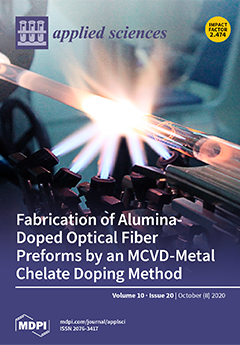Open AccessReview
Micro-LED as a Promising Candidate for High-Speed Visible Light Communication
by
Konthoujam James Singh, Yu-Ming Huang, Tanveer Ahmed, An-Chen Liu, Sung-Wen Huang Chen, Fang-Jyun Liou, Tingzhu Wu, Chien-Chung Lin, Chi-Wai Chow, Gong-Ru Lin and Hao-Chung Kuo
Cited by 76 | Viewed by 9615
Abstract
Visible Light Communication (VLC) technology is an emerging technology using visible light modulation that, in the modern world, will mainly facilitate high-speed internet connectivity. VLC provides tremendous advantages compared to conventional radio frequency, such as a higher transmission rate, high bandwidth, low-power consumption,
[...] Read more.
Visible Light Communication (VLC) technology is an emerging technology using visible light modulation that, in the modern world, will mainly facilitate high-speed internet connectivity. VLC provides tremendous advantages compared to conventional radio frequency, such as a higher transmission rate, high bandwidth, low-power consumption, no health hazards, less interference, etc., which make it more prominent in recent days. Due to their outstanding features, including low cost, low power consumption, etc., µ-light-emitting diodes (LEDs) have gained considerable attention for VLC implementation, but mostly for the ability to be used for lighting as well as communications. In this review paper, we will focus mainly on recent developments in VLC applications and various factors affecting the modulation bandwidth of VLC devices. Numerous factors, such as quantum confined stark effect (QCSE), carrier lifetime, carrier recombination time, crystal orientation, etc. affect the modulation bandwidth of LEDs, and more information will be discussed in the following sections. This paper will focus on VLC applications based on LEDs but mainly on semipolar μ-LEDs and μ-LED-based arrays with high bandwidths. Another important application of VLC is underwater optical wireless communication (UOWC), which has drawn a huge interest in marine exploration and underwater connectivity, but still faces some challenges because visible light is being used. In addition, this paper will focus on how the current VLC system modulation bandwidth can be enhanced. Many methods have been introduced, such as decreasing the active layer thickness or effective active area or using doping, but the bandwidth is restricted by the recombination time when the system configuration reaches its limit. Therefore, it is important to find alternative ways such as optimizing the system, using the blue filter or using the equalization technology, which will be addressed later. Overall, this review paper provides a brief overview of the VLC-based system performance and some of its potential prospects.
Full article
►▼
Show Figures





